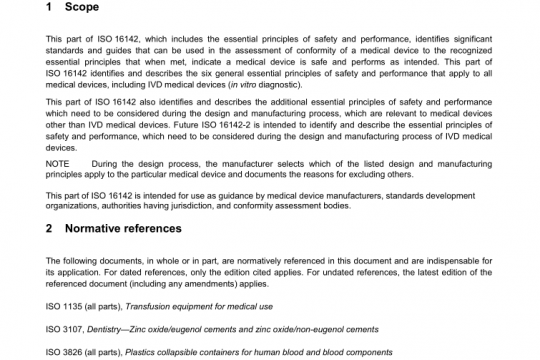ANSI AAMI ISO 10993-15 pdf free download
ANSI AAMI ISO 10993-15 pdf free download.Biological evaluation of medical devices- Part 15: ldentification and quantification of degradation products from metals and alloys.
3 Terms and definitions
For the purposes of this part of ISO 10993, the terms and definitions given in ISO 8044, Iso 10993-1, ISO 10993-9, ISO 10993-12, and the following apply.
3.1 alloy: Material composed of a metallic element with one or more addition(s) of other metallic and/or nonmetallic elements.
3.2 electrolyte: Solution containing ions with the capacity to conduct electric current.
3.3 open-circuit potential: Potential of an electrode measured with respect to a reference electrode or another electrode when no current flows to or from it.
3.4 passive limit potential Ea: Electrode potential of the positive limit of the passive range (see Figure 1).
3.5 breakdown potential E: Critical electrode potential above which localized or transpassive corrosion is found to occur (see Figure 1).
4 Degradation test methods
4.1 General
To identify and quantify degradation products from metals and alloys in medical devices, a combination of two procedures is described. The choice of test procedure shall be justified according to the function of the medical device.
The first procedure described is a combination of a potentiodynamic test and a potentiostatic test. The second procedure described is an immersion test.
The potentiodynamic test is used to determine the general electrochemical behavior of the material under consideration and to determine certain specific points (Ea and E) on the potential/current density curve.
The immersion test is used to chemically degrade the test material to generate degradation products to be analyzed.
If there is the possibility of the loss of a coating from a metallic substrate due to degradation, the potential degradation products from the substrate material shall be considered, as well as the coating itself, In addition, if a metallic substrate coated with a non-metallic material is to be tested, the requirements of ISO 10993-13 and/or ISO 10993-14 shall be considered in order to determine the potential degradation products of the coating.
The identified and quantified degradation products form the basis for evaluation of biological response and, if appropriate, toxicokinetic studies in accordance with ISO 10993-16.
4.2 Prerequisites
The rates of electrochemical degradation reactions are sensitive to small variations in test conditions, instrumentation, sample conditions, and preparation. Therefore, electrochemical degradation testing shall be carried out in an appropriately equipped laboratory by experienced and qualified personnel. This includes proper maintenance and calibration of the test equipment. The methods and operating conditions of the equipment shall also be validated.
NOTE—Fulfillment of electrochemical test conditions for stability, warm-up time, etc., can be demonstrated by conformance to [1].
5 Reagent and sample preparation
5.1 Sample documentation
The general composition of the material(s) under test shall be documented.
5.2 Test solution (electrolyte)
The test solution (electrolyte) to be used shall be appropriate for the intended use of the medical device. All chemicals shall be of analytical grade and dissolved in water of grade 2 in accordance with ISO 3696.
The first choice for the electrolyte shall be an aqueous solution of 0.9 % sodium chloride.
NOTE—Other electrolytes may be used, such as artificial saliva or artificial plasma. Examples of composition are given in annex C. In the test report, the choice of electrolyte shall be justified. If other than an aqueous solution of 0.9 % sodium chloride is used, the pH of the electrolyte shall be specified.ANSI AAMI ISO 10993-15 pdf download.
Other IEC Standards
-

ANSI AAMI ISO 16142-1 pdf free download – non-IVD medical devices and guidance on the selection of standards
AAMI standards list DOWNLOAD -

ANSI AAMI ISO 16142-2 pdf free download – General essential principles and additional specifc essential principles
AAMI standards list DOWNLOAD


